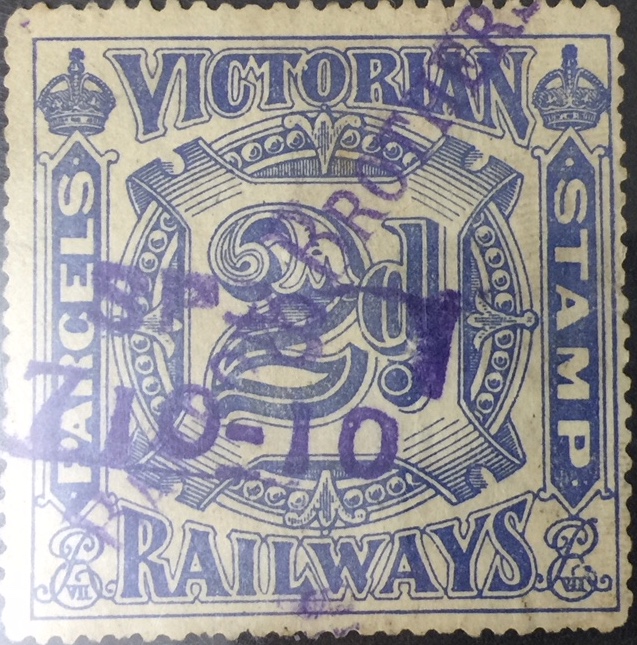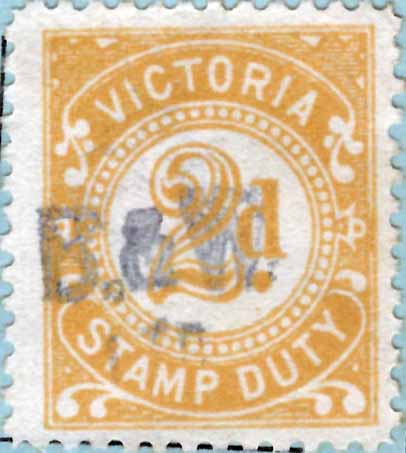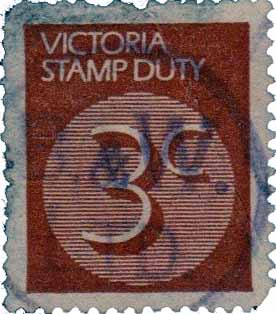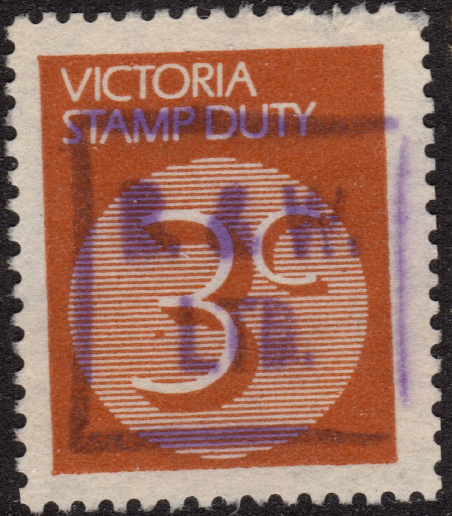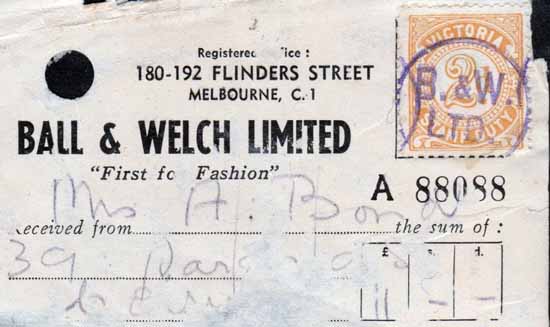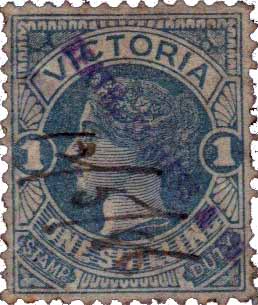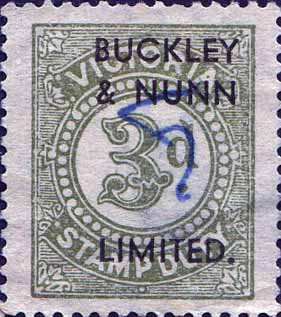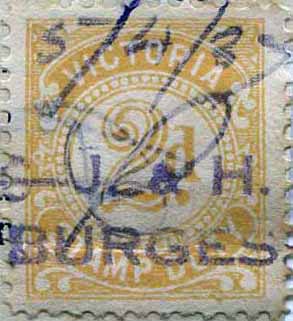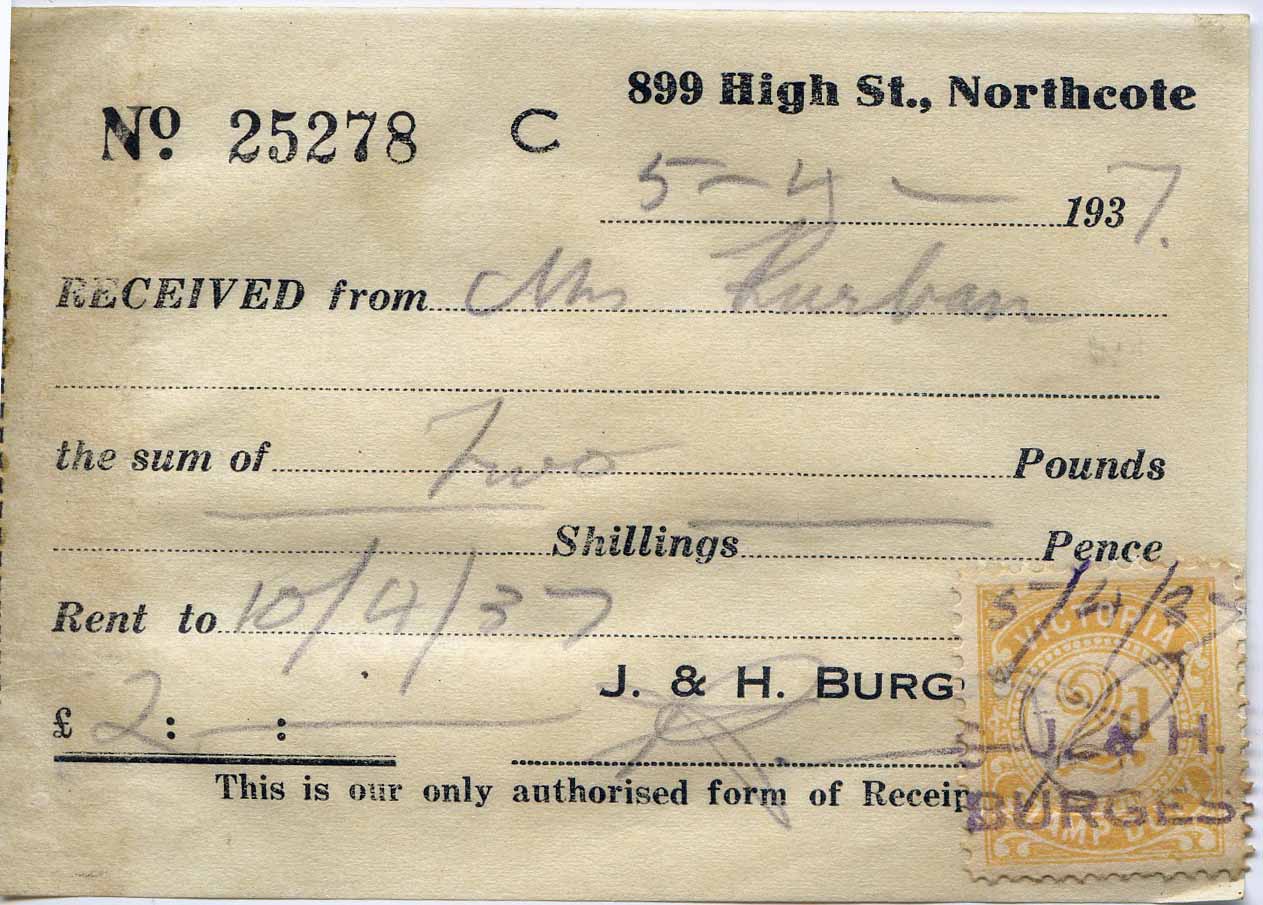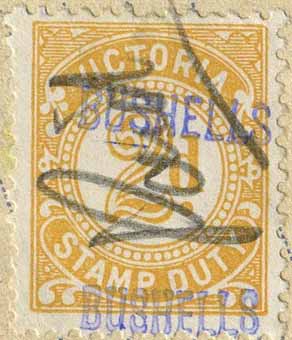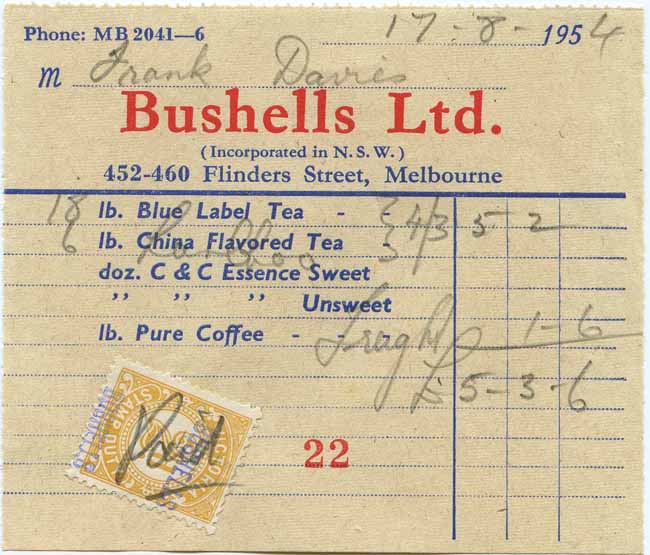|
Private Revenue Perfins of Victoria An Elsmore Coath Howard production The authors would welcome your comments additions or input into this work A B C D E F G H I J K L M N O P Q R S T U V W Y Back to Victoria 'Other' page Back to States Perfin index Back to Commercial Overprint index Section 2 - Commercial Overprints B -------------------------------------------------------- BARROW BROTHERS.a User: Barrow Bros. [unknown] Address: St, Melbourne, VIC Railway Use: 1902 2d Rarity Scale:
1902 2d Background: Device: Handstamp Related Patterns: Nil -------------------------------------------------------- B.&W./LTD.a .a
.b
.c User: Ball & Welch Ltd Address: 180-192 Flinders St, Melbourne, VIC Revenue Use: .a 1932 Series 2d .b 1932 Series 2d .b 1966 Series 3c .c 1966 Series [square] 3c Rarity Scale:
.a 1932 Series 2d R4
.b 1932 Series 2d R4
.b
1966 Series 3c R4 .b 1966 Series [square] 3c R4 Background: Ball & Welch Pty Ltd. Became a prominent Department store in Melbourne from 1899 until the 1970s. The company was founded as a drapery business in the 1850’s by Charles Ball (born Frome, Somerset, England) and his nephew W H Welch. The company’s first stores opened on The Goldfields at Forest Creek, at Vaughan Springs (near Castlemaine, Victoria) in 1861 and they later opened another store at Castlemaine in 1882. In 1874 they opened a large store in the Melbourne inner suburb of Carlton. The large three-storied premises had frontages to Faraday, Drummond and Swanston streets. Eventually an emporium at 180-188 Flinders Street was designed by architects Reed Smart & Tappin and was completed in 1899 in an American Romanesque style. It was extended in 1911 with the purchase of the adjoining Commercial Travellers’ Club. The store occupied around one third of the total block and stretched between Flinders Street and Flinders Lane. The Carlton premises were subsequently used as a warehouse, and this site was the subject of a major fire in 1928. The company opened a Sydney that operated between 1913 and 1924, and the Castlemaine store was finally closed in 1941. With suburban retail expansion in the 1960s, branches were opened in Frankston, Camberwell, and at the Eastland and Southland shopping centres. In its heyday, the Ball & Welch department store was Melbourne’s leading family draper, it’s A to Z departments including gloves, umbrellas and handkerchiefs, mantles, furniture, mercery, millinery, furs and corsets. At one time 26 assistants were devoted to the sale of lace alone. The upmarket department store company Georges Australia Ltd bought Ball & Welch in 1970, closing the stores in 1976 because of declining profits. The Flinders Street store was renovated as Flinders Fair shopping centre in the late 1970s, its façade (including the Commercial Travellers’ Club frontage) were eventually incorporated into the Flindersgate car park building that is located at 172-192 Flinders St, Melbourne. Device: Handstamp Related Patterns: Nil
.b -------------------------------------------------------- BEATH SCHEISS PTY LTD.a User: Beth Scheiss Pty. Ltd Address: St, Melbourne, VIC Revenue Use: 1880 Stamp Duty 4/-, 6/- 1885 Postage Stamp Duty Series 1/- Rarity Scale:
1880 Stamp Duty 4/- R4, 6/- R4
1885 Postage Stamp Duty Series 1/- R4 Background: Device: Stencil Related Patterns: Refer to BS/&Co.a in Victorian Perfin Section: -------------------------------------------------------- BRIGHTS.a User: Brights & Hitchcock Retailer Address: Moorabool St, Geelong, VIC Revenue Use: 1932 Series 3d Rarity Scale:
1932 Series 3d R4 Background: *The Bright and Hitchcocks store had its origins in two stores, one run by the Hitchcock brothers in Yarra Street, and the other by William Bright in Moorabool Street. The two businesses merged in 1855, and their store opened under the "Bright and Company" name on the south-east corner of Moorabool and Little Malop Streets. The name "Bright and Hitchcocks" was adopted in 1861, even though Bright retired in 1865. Son of one of the founding brothers,Howard Hitchcock, was the last of the family to be involved with the store, retiring in 1927. Bright and Hitchcocks became a public company in 1950 with almost 600 shareholders. 1959 saw the company purchased by Foy and Gibsons Ltd, who then merged with Cox Brothers. Cox Brothers ran into financial problems in 1966, and in March 1968 saw the store sold to new owners, who changed the name to "Brights". It was sold again in January 1969 to Sydney based Burns Philp and Co, who renamed the store to "Mates".
The final sale was in 1976 when Chas Moore took over the lease, changing the name again, this time to "Moores". 1979 saw Moores closed. The building was divided into a number of smaller stores at street level. The past decade has seen the upper floors empty. The basement was occupied by a Spotlight fabric store until 2005. The exterior of the building underwent a repaint and minor refurbishment in 2006. Device: Preprinted Related Patterns: Nil *Wikipedia -------------------------------------------------------- BUCKLEY/& NUNN/LIMITED..a User: Buckley & Nunn Limited Drapers, later becoming a Department Store Address: 300-310 Bourke St, Melbourne, VIC Revenue Use: 1932 Series 3d Rarity Scale:
1932 Series 3d R4
Background: *Buckley & Nunn
was co-founded by Mars Buckley (1825?–9 October
1905) and his partner, Crumpton John Nunn
(1828–1891). Buckley was born at Mallow, County
Cork, Ireland and emigrated to Victoria in 1851
with his wife, Elizabeth Maroon, née Neville, and
their child. Buckley came with goods to sell at
the Ballarat and Forest Creek goldfields, which
proved profitable. On the arrival of another
consignment of goods in 1852 he began business in
partnership with English-born Nunn as Buckley
& Nunn. Nunn soon returned to England to
manage that end of the business. Device: Preprinted Related Patterns: Nil *Wikipedia -------------------------------------------------------- BURGESS.a User: J & H Burgess Real Estate Address: 899 High St, Northcote, VIC Revenue Use: 1915 Series 2d Rarity Scale:
1915 Series 2d R4 Background: The real estate business of J(ohn?) and Henry Burgess is first recorded in July, 1929, located at 899 High Street, Northcote, (later changed to the more fashionable Thornbury) where the business was still found in August, 1957.
Between September, 1936, and July, 1937, J & H Burgess had a city office at 190 Bourke Street, Melbourne. From July, 1937, Hamble & Co. Pty Ltd, real estate agents, occupied 190 Bourke Street.
In January, 1937, J & H Burgess opened offices at 2 Sydney Road, Coburg, which ceased operating in February, 1940, and became Bourke & Simpson, real estate.
In September, 1942, for one month only, J & H Burgess advertised an agency in Eltham, apparently not operating under their business name.
J & H Burgess was operating from 899 High Street, Thornbury, in November, 1950, after Henry Burgess died in Thornbury in August, 1950. Device: Handstamped at the Northcote office. No other devices from the other offices have been reported. Related Patterns: Nil -------------------------------------------------------- BUSHELLS.a User: Bushells Ltd Tea Merchants Address: 313 Lttle Collins St, Melbourne, VIC 452-460 Flinders St, Melbourne, VIC Revenue Use: 1932 Series 2d, 3d, 6d Rarity Scale:
1932 Series 2d R4, 3d R4, 6d R4 Background:* Alfred Thomas Bushell, founder of Bushells Australia, was born 25th May 1833. The Bushells family were heavily involved in the tea business, Alfred being a Tea Dealer who employed 50 men and 45 boys, whilst his wife Agnes was the sister of the founder of Brooke Bond, the English Tea Company. Following the death of his wife, Agnes in the early 1880's, Alfred traveled to Brisbane and by 1883 was trading in Brisbane selling both tea and coffee from a shop. Some years later, two of Alfred's sons started selling tea in Sydney trading as Bushell and Company - the Tea Men. The Sydney business was expanded from selling tea on a roadside stall to selling tea wholesale. In 1899 the business expanded further when a branch was opened in Melbourne.
By 1902 Alfred and his sons, Walter and Phillip, were well established as tea traders, but all was not well. The sons disagreed with the way their father was running the business and on 14th July 1903 the partnership with father Alfred was dissolved. Alfred retained Queensland while Walter and Phillip took control of Sydney and Melbourne. It appears to have been an amicable parting of the ways as the brothers continued to use their father's picture on the packet to attract the more conservative customers.
In 1908, Alfred was contemplating retiring from business and was 'desirous of assigning' the Queensland business to the two sons. A memorandum of agreement stated that Alfred had the 'express desire that the surname shall continue to be identified with the business'. Following Alfred's death in 1910, Bushells Ltd was registered as public company. In 1915 an agent was appointed in Western Australia.
By 1918 Bushells Ltd had expanded into Tasmania and South Australia, but this was not without its problems. The company had over extended itself and the bank was proving difficult in assisting with the cash flow problems. It was later reported that Phillip was 'really' worried and called the staff together to explain the situation. According to an interview at the time, 'The staff kicked in the money from their own resources. The crisis was overcome with money from the employees. Most of them decided to be paid back in shares rather than cash, and many finished up very well off'.
Land was purchased in 1920 in the area now known as 'The Rocks' in Sydney. It was here that Bushells was to build its seven-story head office and incorporate new tea blending and packing methods of both tea and coffee. This was to remain the head office and tea factory for the next 40 years.
In 1937 Bushells Ltd formed a company in New Zealand. To introduce their product to New Zealand the company sent every housewife on the electoral roll a personally addressed letter together with a card entitling her to a half pound (225g) of tea, completely free of charge. This quickly established the company and within a year it had a huge section of the tea market.
In about 1945, J.A.D. Gibson Pty Ltd, who had previously sold the tea division of their business to Robert Timms, was itself taken over by Bushells. At this time Gibsons was manufacturing coffee essence and roasting coffee in Sydney and in Newcastle.
In 1955 Bushells took over their long time rival in the New South Wales market, Inglis Ltd. The purchase of the company brought with it a significant number of brands ranging from matches (Red Head) to canned fish, sauces, wine and spirits and a flour mill in Ultimo that produced a type of porridge. There is even a record of owning a patent for a 'clothes drying apparatus'. Included in the beverage list were the teas 'Billy Tea' 'Goldena', Aromatte, 'Kofe-Kol' and 'Uncle Tom's Pure Coffee'. For a number of years the company continued to trade in its own name, but gradually the factories and depots were amalgamated into Bushells.
In the mid 50's a decision was made to move the Bushells Head Office. Employees at the time state that the main reason for deciding to move west was the belief that the city itself was expanding that way. Several sites were examined before the current Concord site was chosen. According to records the purchase date is identified as being on Christmas Eve, 1956 and was for 85,000 pounds ($170,000).
It is believed that a timber yard was operating on the site prior to the purchase, with a weatherboard building along one boundary leading onto a jetty sitting on piles. Apart from this the site was substantially clear and ready for immediate development, so indicative plans were drawn up and spray drying equipment and six instant coffee extractors were ordered from America.
The initial design of the Concord factory was to accommodate tea packing and warehousing. Indications are that some tea production commenced at the Concord site early in 1958 and that the equipment was transferred from The Rocks. The Newcastle tea plant was closed in 1963, as progressively were the other factories in Perth, Queensland and Victoria.
In 1978 the Bushells family made the decision to sell their shares and approached their cousins, Brooke, in England. The Brooke Bond company was still substantially owned by the Brooke family, but operated under the name of Brooke Bond Liebig Ltd.
At the time, newspaper reports indicated that there was some resistance to a non-Australian company purchasing the business, but the government was in the process of relaxing its policy of overseas ownership. Objections to the take over by Brooke Bond Liebig Ltd were overcome and following the sale of the shares, Bushells donated and established a public plaza. The plaza, known as 'Bushell Place', is in The Rocks area in Sydney.
Throughout the 1980's the company continued to make substantial investments in its coffee business. The instant coffee extraction plant was rebuilt in 1981, a new continuous roaster for the instant coffee was installed in 1982 and a new instant coffee agglomerator in was installed in 1985. Unilever acquired the company through their purchase of the Brooke Bond business in 1988.
In 1998, as part of an acquisition of coffee brands from Unilever, FreshFood Services Pty Ltd purchased the Bushells coffee brand. The tea brand still remains with Unilever. The coffee continues to be produced at the Concord Factory. FreshFood also purchased the New Zealand division of Bushells coffee. Device: Stencil Related Patterns: Nil *bushellscoffee.com.au -------------------------------------------------------- A B C D E F G H I J K L M N O P Q R S T U V W Y Back to Victoria 'Other' page Back to States Perfin index Back to Commercial Overprint index © copyright 2011 |
